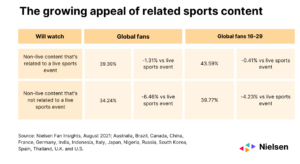
TV programming has a long history of inspiring audiences to get more involved in their passions and pick up new hobbies. In some cases, TV shows have given a lucky few the opportunity to live out their dream jobs, such as Last Comic Standing winner Iliza Shlesinger and Top Chef winner Stephanie Izard.
But TV programming can do more than just fuel internal passions: In the case of docuseries, which are becoming increasingly popular on streaming platforms, Nielsen research has found that they can transform audiences into sports fans.
There’s no short-changing the power of sports and its influence on live TV viewing. Last year, sports accounted for 98% of the top 50 most-viewed programs through September on traditional U.S. TV. And as content creators expand the TV landscape to grow—and attract—new audiences, the world of sports is growing outside of live competition.
While match highlights and recap videos have always provided audiences with a way to catch up with live competition and gain insight into on-the-field action, non-related content, like docuseries are also gaining momentum among viewers—and inspiring them to engage with sports firsthand. In fact, among global audiences, the appeal of content that’s unrelated to a live event is just slightly less than the content that’s directly related to a match or game.

To learn more about the connection between the viewership of docuseries and sports fandom, Nielsen recently analyzed viewership of Netflix’s Formula 1: Drive to Survive to see if it inspired U.S. audiences to start watching Formula 1 races. The analysis, which looked at F1 viewership during three specific periods, found that more than 360,000 viewers who didn’t view F1 in the latter part of the 2021 season, watched F1 racing in 2022 after first watching Drive to Survive.
Driven to watch: Drive to Survive inspires 2.3% more viewers to F1 content in 2022
Nielsen isn’t the first to highlight the impact of Drive to Survive on F1 fandom, and Nielsen Fan Insights has tracked F1 fan growth of about 10% in the U.S. over the past three years. But this is the first time audiences have been analyzed to track the halo effect from the show to live action—something earlier coverage stated couldn’t be done.

To arrive at the findings, Nielsen calculated the television viewership of:
- F1 content between Nov. 19, 2021, and Dec. 12, 2021
- All seasons of Drive to Survive between Dec. 13, 2021, and March 17, 2022
- F1 events between March 18, 2022, and April 10, 2022
According to Nielsen data, nearly 16 million people watched at least part of any of the programming listed above. Of the 16 million, 2.3% did not watch any of the last three race weekends of 2021 F1 programming, highlighting that Drive to Survive generated more than 360,000 new fans of F1 ahead of the highly anticipated Formula 1 Crypto.com Miami Grand Prix, which begins this Friday.
When we look at viewership of just the docuseries and the new F1 season, which kicked off in mid March, we see that 41% of Drive to Survive viewers also tuned in to the first three weeks of the new F1 season.
[infogram id=”c4969490-7d29-47da-9de9-2bcf4e65a4fa” prefix=”mwm” format=”interactive” title=”Drive to Survive Viewership by Season”]
The new fans also bring a different profile to the sport. They are:
- More Hispanic (23% vs. 12% who watched F1 content and not the docuseries)
- Younger (46% are 34 and younger vs. 16% who watched F1 content and not the docuseries)
- Affluent (69% earn $100k+ vs 49% who watched F1 content and not the docuseries)
- White collar (70% vs 42% who watched F1 content and not the docuseries)
- Have homes with kids (49% vs. 21% who watched F1 content and not the docuseries)
In addition to inspiring docuseries viewers to become F1 fans, Drive to Survive has played a significant educational role as the general population grows its interest in the sport. In fact, among the general population, Nielsen Fan Insights found that:
- 34% became a fan after watching
- 30% say the understood the sport more
- 29% felt more engaged with the sport
Given the buzz to date, it should come as no surprise that the fourth season of Drive to Survive has garnered even bigger audiences. Premiere week for season 4, which dropped March 11, just ahead of F1 Round 1 in Bahrain, attracted 60% more audience than the premiere for season 3, which arrived right before last year’s F1 season.
Compelling stories are everywhere, and sports are increasingly gaining TV screen time outside of live competitions. While there’s no denying the attraction of live sports, there is now clear evidence that one of the keys to attracting new fans might be rooted in the power of compelling, documentary-style storytelling.
Note: Nielsen national TV data and Streaming Content Ratings